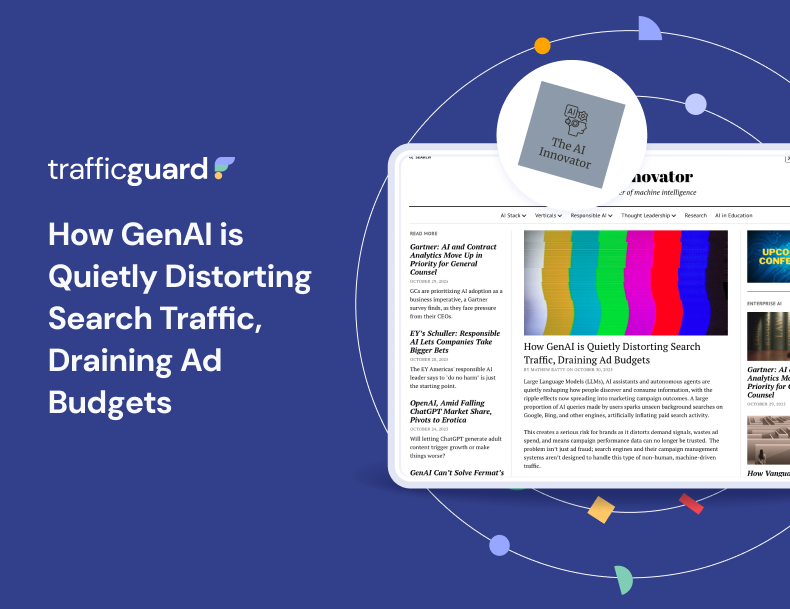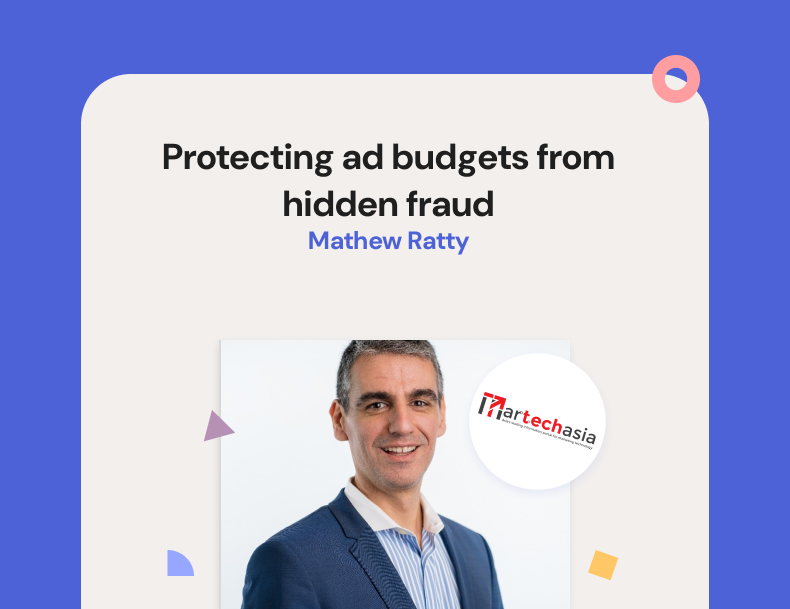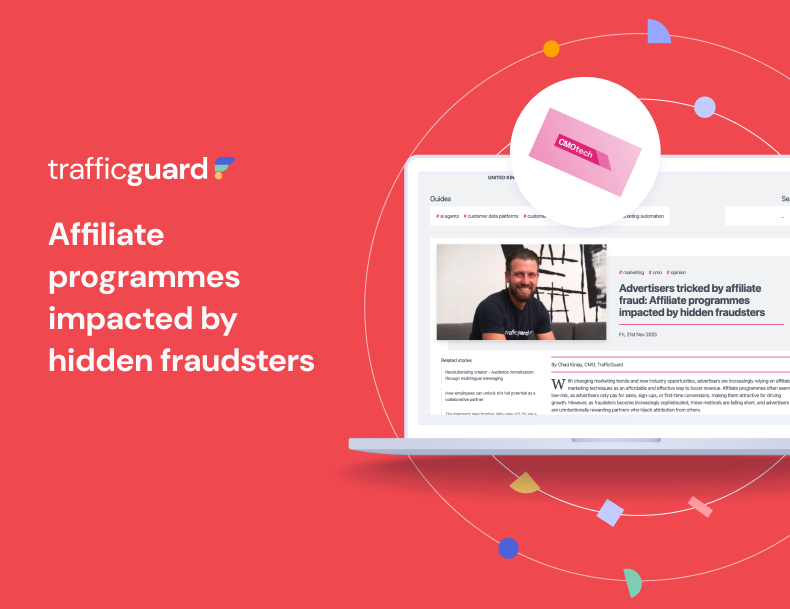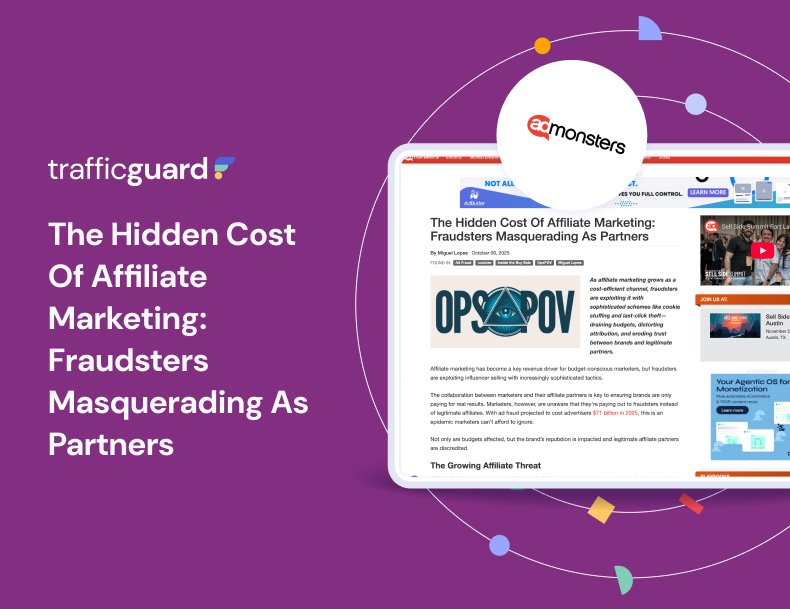How GenAI is Quietly Distorting Search Traffic, Draining Ad Budgets

How GenAI is Quietly Distorting Search Traffic, Draining Ad Budgets
By Mathew Ratty on October 30, 2025
Large Language Models (LLMs), AI assistants and autonomous agents are quietly reshaping how people discover and consume information, with the ripple effects now spreading into marketing campaign outcomes. A large proportion of AI queries made by users sparks unseen background searches on Google, Bing, and other engines, artificially inflating paid search activity.
This creates a serious risk for brands as it distorts demand signals, wastes ad spend, and means campaign performance data can no longer be trusted. The problem isn’t just ad fraud; search engines and their campaign management systems aren’t designed to handle this type of non-human, machine-driven traffic.
This non-human traffic blends in effectively with legitimate users, leaving campaigns vulnerable. If action isn’t taken, companies face inflated searches quietly draining their budgets and impacting advertising efficiency.
Reshaping the search landscape
User behavior is shifting away from traditional search engines as AI agents are quickly becoming the go-to medium for how people search and interact online. Tools like ChatGPT generate responses based on their training data without performing live searches on the web.
However, not all LLMs behave this way. Some LLMs and autonomous AI agents actively behave like human users on search channels. They navigate engines, click links, and interact with sites. This behavior can artificially inflate search volumes and ad clicks, polluting the data marketers rely on and driving up costs in paid search campaigns.
Users are drawn to them as they get answers faster, and AI agents can even learn user preferences and contextual information to deliver a more personalized experience. Their popularity has grown considerably, as Bain and Company reports that around 80% of U.S. users are already relying on AI summaries for at least 40% of their searches. While more efficient for users, these tools have presented a challenge for brands and marketers as they have to navigate a rapid change in the search landscape.
Traditional ad-supported channels and brand sites face diminished traffic as AI searches reduce the need to click on the original sources. Users interact less frequently with ad-supported channels and ads are pushed below AI-generated content, threatening ad revenue and lead generation.
Threats to budgets and decision-making
Brands are having to optimize their tactics for this new era of searching to avoid budget losses and remain relevant. However, while marketers are focused on how to optimize their tactics for AI searching, they aren’t aware of how their ad spend is already being impacted.
When users enter queries into LLMs, these programs generate answers using multiple sources, sometimes triggering background searches across search engines. Meanwhile, autonomous AI agents can actively navigate the web and click on links. Together, they contribute to inflated search volumes and ad clicks, which can artificially drive up paid search activity when they interact with a brand’s site.
Paid search campaigns are run with a set budget, and the influx of traffic from LLM search queries and AI agents can quickly eat away at this budget. This wastes ad spend as the campaign is taken down when the budget is reached before potential users get a chance to see it. Brands then miss out on new leads without even realizing it.
The impact doesn’t stop there, as artificially inflated traffic distorts campaign performance data. The data no longer reflects true performance as high traffic numbers make campaigns look successful, but these numbers are coming from AI, not interested users. Future decisions are then influenced by inaccurate data, and marketers could mistakenly direct resources to underperforming campaigns.
Ensuring data accuracy
Traffic from AI agents is particularly harmful to campaigns as ad fraud systems aren’t looking for it. Non-human traffic like AI agents blend in with regular, legitimate traffic and don’t appear outwardly hostile or dangerous. Systems therefore allow these fake users to continually engage with the campaign, despite adding no value as they aren’t intent on making a conversion.
It’s integral that marketers are fully aware of the traffic coming into their site. By closely and regularly monitoring traffic at the user level, it’s possible to identify if they are offering genuine incremental value. Marketers can then determine if their traffic is actually coming from machine-driven queries as opposed to legitimate users and filter them out of their campaign data to make better-informed decisions.
AI-powered agents or bots have become more difficult to identify as they can mimic typical user behavior. This disguise isn’t flawless, however, and there are markers that can be used to differentiate them from human users. A sudden spike of visitors without a matching spike in conversions is a potential sign of AI bots scanning the site. A high bounce rate is another indicator of AI activity, as they will enter a site quickly and leave without staying to convert. Being able to pick up on these warning signs is an essential step for marketers to take in order to prevent their data from being distorted.
A sudden spike of visitors without a matching spike in conversions is a potential sign of AI bots scanning the site.
Strengthening identity verification is a further step that marketers can take to mitigate AI-powered traffic. AI-powered bots are less likely to be able to bypass robust measures such as CAPTCHAs or more detailed user information checks, preventing them from eating up ad spend.
Modern AI-driven bots can be identified and blocked after the first click using IVT and ad fraud tools, which analyze behavioral patterns across multiple parameters. However, traditional safeguards alone aren’t enough. It’s important to have independent, sophisticated validation on search channels to accurately measure and mitigate bot-driven activity, ensuring campaigns aren’t silently losing performance and budget.
LLMs and AI agents are only going to rise in usage. The way they have revolutionized searches for users has skyrocketed their popularity. As well as embracing tactics to optimize their projects for AI searches, marketers need to also take steps to protect themselves from the negative effects of these queries on their campaigns.
Traditional fraud tools weren’t built with AI in mind, allowing them to enter systems unimpeded. Marketers can implement tactics to compensate for this and prevent AI from distorting campaign data and draining advertising budgets. Analyzing traffic in depth is key to protecting budgets and unlocking the full potential of campaigns.
Read the full article at The Ai Innovator.
Get started - it's free
You can set up a TrafficGuard account in minutes, so we’ll be protecting your campaigns before you can say ‘sky-high ROI’.
He is the Co Founder and current Chief Executive Officer of Adveritas and TrafficGuard since 2018. Prior to this Mr Ratty Co-founded MC Management Group Pty Ltd, a venture capital firm operating in domestic and international debt and equity markets, who are also substantial shareholders in the Company. At MC Management, Mr Ratty held the role of Head of Investment and was responsible for asset allocation.
Subscribe
Subscribe now to get all the latest news and insights on digital advertising, machine learning and ad fraud.







